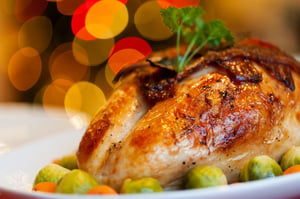 Covid-19 can’t cancel Thanksgiving 2020, but it sure can shrink it.
Covid-19 can’t cancel Thanksgiving 2020, but it sure can shrink it.
Banning large gatherings and the fear of infecting grandma have shrunk the Thanksgiving holiday to an almost unrecognizable form.
The CDC has recommended an outdoor version of the holiday where everyone brings their own food, no potluck, buffet or shared utensils.
What does an outdoor Thanksgiving mean to a market researcher?
The turkeys shrink, but the markets grow.
Patio heaters — from fire pit kits to gas radiant patio heaters — are unfindable, with more than $570 million in sales in the US last year. And the 5% compound annual growth rate for propane is exploding.
And while we expect Americans to gorge on the holiday staples without regard to portion-control, ingenuity is making itself known.
Costco shifted from its beloved half sheet cakes to emphasize its smaller 10” round cakes as more suitable for smaller celebrations or just because now you can eat the whole thing yourself.
But this could mean fewer leftovers. While re-usable containers have sealed the deal during Covid, they take a hit as the farmer gods created smaller birds, slicing down on leftovers.
Grocers are shrinking their seafood and appetizer platters as well, which means fewer shrimp, less cocktail sauce, cheese and crackers.
Despite a sluggish restaurant business, the carryout and delivery foodservice are very thankful this season, approaching $380 billion this year. This growth, along with changing hygiene habits, have lifted the disposable packaging market past the $15.5 billion mark.
Historically we took pride in cooking the meal ourselves and claiming it was “homemade,” but curbside carryout of family-style meals has lost its stigma.
But even with the growth in carry out, and OPC (other people cooking) Americans are still whipping up family favorites with spices, oils, vinegars and marinades — already worth $4.3 billion in US sales — are hot and spiking as we have more small gatherings which means more cooks in their own kitchens.
Everything from fully-cooked stuffing and gravy to meal kits have heated up past the $4 billion mark as home cooking increased in the pandemic era and families looked for convenient ways to access groceries and explore new types of cuisine.
But even if you are headed over the river and through the woods, you are less likely to bunk in the single bed of your high school bedroom. While hotel occupancy is in the gravy, revenues from lodging services such as rentals, cabins and cottages are bringing home more than $1.5 billion business in the US.
So whether you’re eating indoors or out, alone or socially-distanced, carry-out or homemade, Covid-19 can shrink a holiday, but somewhere a market is growing.
Want more market data? Check out the COVID-19 Economic Impact Tracker for all the latest.
About the author: Robert Granader is CEO of MarketResearch.com, a producer and aggregator of industry insights. His work has been featured in The Washington Post, Washingtonian magazine, and The New York Times.

